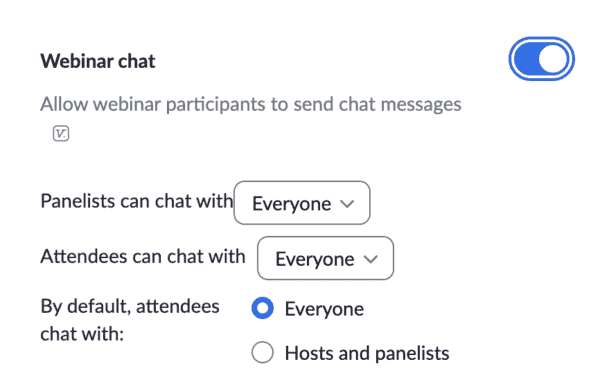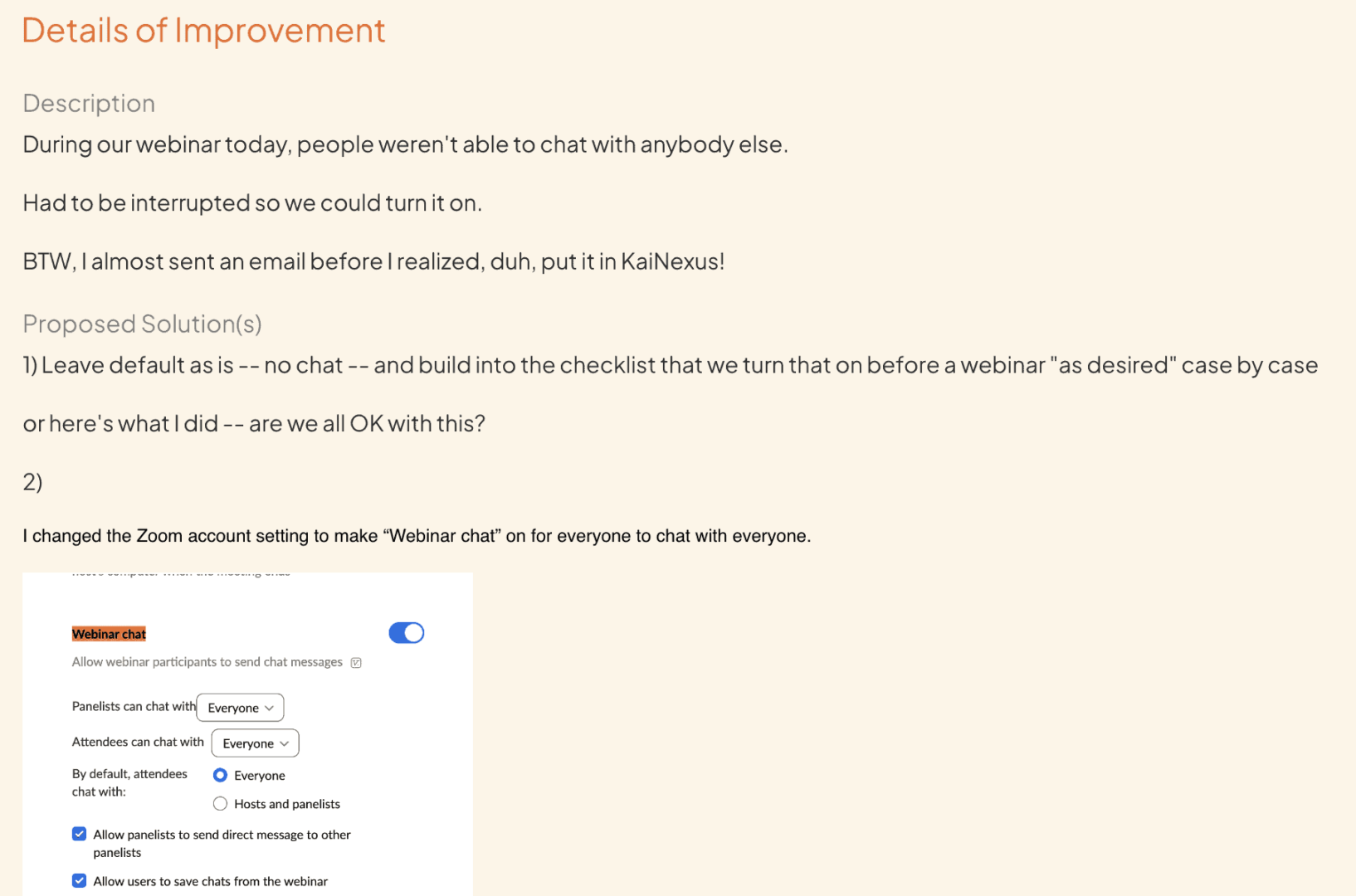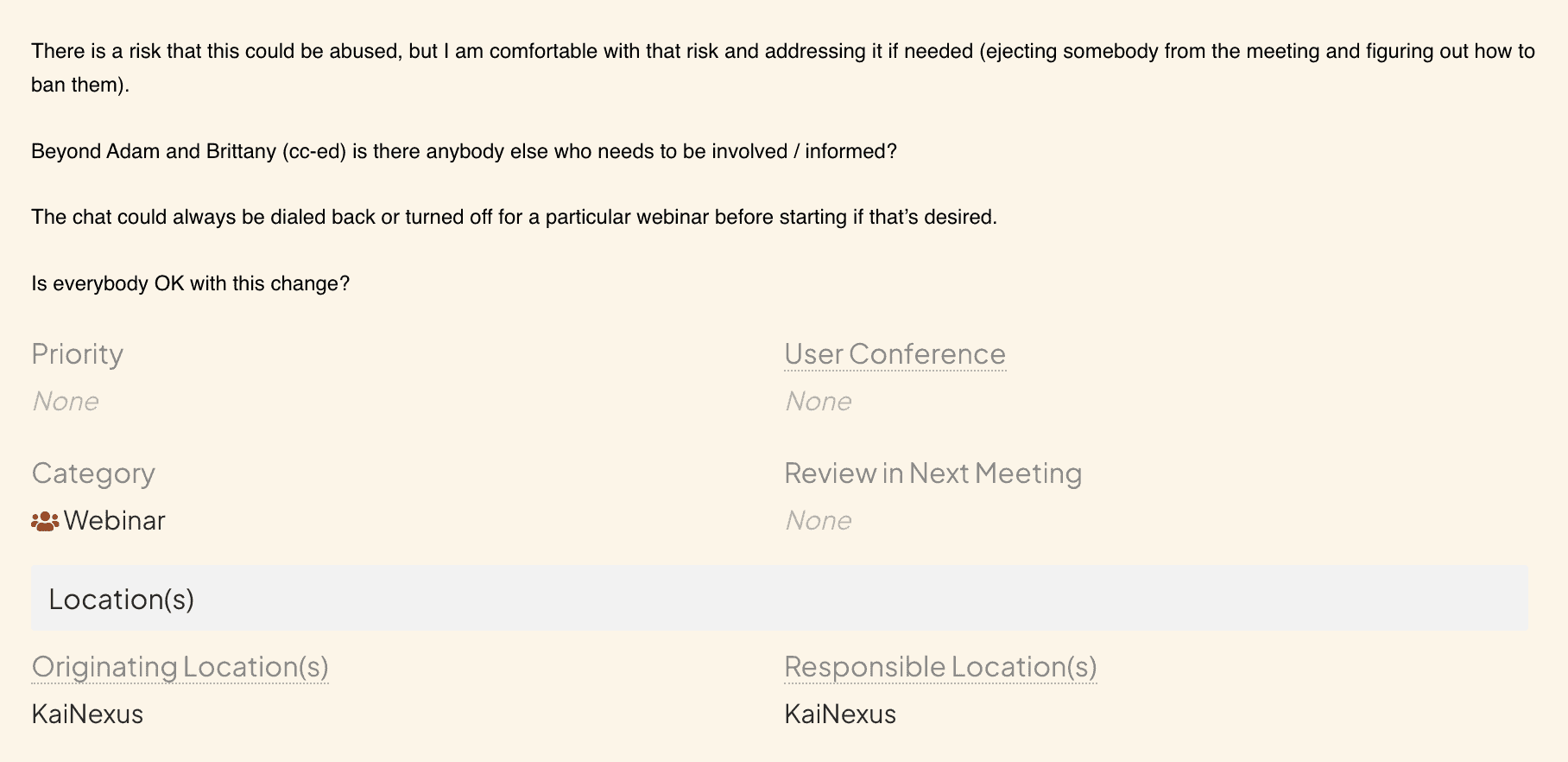I don't blog about every mistake I make (although it might seem otherwise, sometimes). I do try to share stories that might help illustrate concepts about Lean or problem-solving.
This past week, within about 24 hours, there were three examples of “things gone wrong” that seemed to have a few common themes in terms of how I responded.
Mistakes often lead to problems (but not always). Not all problems are caused by “mistakes.”
Do Not Enter!
On Thursday, Dr. Greg Jacobson, co-founder, and CEO of KaiNexus, were getting ready for Episode #30 in our “Ask Us Anything!” series.
As we do, we were using the webinar checklist that helps us prevent some mistakes. This checklist grows and evolves over time, based on new mistakes that we discover. I've blogged about this before.
Since Greg was at the Austin KaiNexus office, he followed the part of the checklist that says to put a sign on the door that says “DO NOT ENTER – WEBINAR IN PROGRESS.”
Since I was working from home, alone, I didn't have to do that.
The sign is meant to be more specific than a vague “do not enter” — sharing detail about “the why” helps and nobody wants to interrupt a webinar.
About a minute before we went live, somebody entered the room Greg was in.
He turned and asked:
“Didn't you see the sign?”
He didn't sound too snippy about it. They left.
Short-term countermeasure: Tell or ask the person to leave
But Greg quickly realized that he was blaming the person who walked in. He came up with a long-term countermeasure that we can test to see if it works better.
Long-term countermeasure: Put the sign on the door so it literally covers the door handle.
Hypothesis: The sign is less likely to be “missed” that way.
All we can do is try it out next time. We'll be “testing the hypothesis” instead of “implementing the solution.”
Why Isn't Chat Working?
As we got started with the “Ask Us Anything!” session, Greg got a message from a member of the KaiNexus team. They told Greg that the “chat” function within Zoom Webinars wasn't working.
That was a surprise to me.
Short-term countermeasure: With a few clicks, turn Chat on.
We had momentarily “stopped the line” to get that sorted out. And then we continued. The proverbial “fire” was put out.
We had “contained the problem.”
There's a time and a place for deeper troubleshooting — and that time was AFTER the webinar.
When we finished, I was able to go into the Zoom Webinar settings. It turns out there was a setting that was set to “off.” Again, that was news to me.

This hadn't been a problem in previous webinars. Attendees were able to chat, even if that had been limited to them sending chats to “Host and Panelists” — or we could turn on the ability to chat with everybody with a few clicks.
This wasn't a “mistake” per se, it was really more of a problem that just seemed to appear.
Long-term countermeasure: Turn that Chat setting on.

Now, there were several questions I didn't know the answer to:
- Was this a new setting in Zoom Webinars? It's not worth investigating the history of that.
- Did somebody on the KaiNexus team who does Webinars (for customer education, etc.) turn that setting off? I would ask instead of assuming, and it was nothing to be upset over.
- How do others on the team who do Webinars feel about this change? I would ask instead of assuming.
In many organizations, I'd send an email.
At KaiNexus, we use the KaiNexus platform to discuss and log “opportunities for improvement.” I put it in KaiNexus. I first made the mistake of starting to write an email. I almost made the mistake of sending it. Thankfully, I was able to copy and paste what I had written into KaiNexus:


I asked for input, and I got some:

So my proposed long-term countermeasure was adopted. It would have been better if Adam had flagged this when he noticed the problem recently. It could have been solved and addressed before our “Ask Us Anything!” session, but that's OK. Nobody was injured in the process. Was it a “mistake” that he didn't report the problem? Maybe, but it wasn't a huge mistake and it didn't have a horrible outcome.
Thinking of healthcare, a small problem might risk harming a patient (or a co-worker). When safety is involved, it's critically important that we have a culture that encourages people to speak up about problems. I'm sure Adam from KaiNexus would have felt safe speaking up, but maybe he just didn't take the time or didn't think to follow up. Those things happen. Again, it's OK.
We put the “fire” out. Our hypothesis seems pretty solid that making that change will be effective. There still is the risk of a “bad actor” abusing the Chat function — and we'll address that individually, as needed.
For that problem, the short-term countermeasure would be kicking that person out of the webinar. The long-term countermeasure might be banning them from future webinars.
Oops, You Didn't Know?
The next morning, I was in a meeting with a group from Value Capture.
We've been planning a webinar I'll be co-presenting on October 18th. I hope you'll join us, by the way.

The marketing team has been very focused on promoting this webinar to our external contacts, email lists, and social media.
In the meeting, I mentioned the webinar and gave some updates about some marketing experiments that were underway.
One of our Value Capture team members proverbially “pulled the andon cord.”
In plain language, he spoke up.
“What's this webinar that you're talking about? I'm not aware of it.”
That wasn't his fault, that was mine. Or it was the marketing team's mistake. But I own it. My mistake. I said:
“Thank you so much for pointing that out!”
Short-term countermeasure: I told him a little bit about the webinar.
Then, it was time for broader countermeasures for the rest of the Value Capture team.
Short-term countermeasure: Forward the recent marketing email newsletter about the webinar to our internal team.
This begged the question of “why isn't everybody on our team getting these marketing emails”?
Long-term countermeasure: Make sure everybody on the Value Capture team is signed up for these.
There are other long-term countermeasures that could be put in place:
- Process for adding new employees to that marketing email list
- Implement other ways to spread the word specifically about webinars to the internal team
The General Pattern
What was the general pattern in these situations?
- Somebody identifies a problem
- Somebody speaks up about the problem (if necessary)
- A “short-term countermeasure” is used to “contain” the problem or to put the fire out, short term
- As time allows, do a deeper investigation, as required
- Then, test “long-term countermeasures” that are designed to prevent the problem from reoccurring
- Evaluate those countermeasures over time
My Upcoming Book
If you're interested in learning from mistakes and how to create a culture of learning from mistakes, check out the book that I'm currently writing, based on stories and lessons from the “My Favorite Mistake” podcast series.
You can also sign up to get more information about this as it progresses.

Please scroll down (or click) to post a comment. Connect with me on LinkedIn.
Let’s work together to build a culture of continuous improvement and psychological safety. If you're a leader looking to create lasting change—not just projects—I help organizations:
- Engage people at all levels in sustainable improvement
- Shift from fear of mistakes to learning from them
- Apply Lean thinking in practical, people-centered ways
Interested in coaching or a keynote talk? Let’s start a conversation.









